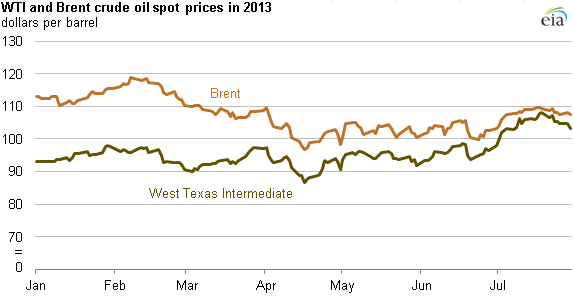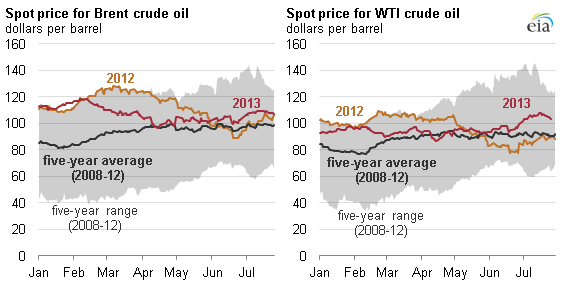Skip to comments.
Analyst predicts growing N. American production unless oil falls to $60
Fuel Fix ^
| October 8, 2013
| Zain Shauk
Posted on 10/08/2013 2:15:28 PM PDT by thackney
North American oil production is showing no signs of slowing down and will likely continue growing even if prices fall to around $60 a barrel, more than $40 below today’s price, an analyst said at a Houston conference Tuesday.
Tony Scott, manager of oil and gas analysis for Bentek Energy, said the $100-plus price means high returns for oil companies. With companies cutting their costs and improving their production methods, their work probably will remain lucrative at far lower prices, he said.
U.S. benchmark light, sweet crude ended up 46 cents at $103.49 a barrel Tuesday on the New York Mercantile Exchange.
“We’ll see a slowdown at $80, but it’s not going to be a dramatic slowdown,” Scott said at the Platts Commodity Week conference held at the Hilton Americas in downtown Houston.
Scott said that production is likely to continue growing unless prices fall to as low as $60 a barrel.
“It takes really low prices to really slow this engine down,” he said.
Scott’s expressed a positive outlook for North American oil production.
North American oil production will jump 4 million barrels a day by 2018, likely cutting out imports of crude, Scott said.
The U.S. now imports 500,000 barrels a day of light, sweet crude, Scott said, and growth in the Eagle Ford Shale of South Texas alone may eliminate those imports.
Oil companies working in the Eagle Ford will boost production there to more than 1 million barrels per day by the end of 2013, and to more than 1.5 million barrels per day in 2018, Scott projected.
New drilling technology also is reviving the Permian Basin region of West Texas, long an oil producer for the state, and it’s becoming a mammoth source of fossil fuels, he said.
The resurgence could make the Permian the most productive basin in the U.S, Scott said.
Scott predicted that production will grow throughout North America, regardless of delays surrounding parts of the Keystone XL and other pipeline projects.
He said rail transportation of oil produced throughout the continent, even from oil sands plays in Canada, remains convenient for oil companies. That’s because prices for rail transportation will not substantially affect returns, he said.
“At $100 crude, everything is economic,” he said. “At $20 pipeline costs, $20 rail costs, you’re still getting $80 at the wellhead.”
Growing North American oil production means that ships full of oil that previously headed to the United States are being redirected to Asia, he said. But with oil demand in China and India not growing as fast as expected, the result will be more available crude in the market, he said.
“It’s going to dramatically change how the world prices crude,” he said.
If world demand for oil does not grow, “it’s going to put a lot of downward pressure on prices,” Scott said.
John Kingston, global editorial director for Platts’ news division, opened the conference by noting that six years ago he attended a peak oil conference at the Hilton Americas, where experts warned that the global supply of crude was running short.
“Back then, their numbers looked like maybe they were really onto something,” Kingston said.
The Association for the Study of Peak Oil & Gas USA had canceled this year’s peak oil meeting, he said.
“That was six years ago in this hotel and now look where we are,” Kingston said.
TOPICS: News/Current Events
KEYWORDS: energy; oil
1
posted on
10/08/2013 2:15:28 PM PDT
by
thackney
2
posted on
10/08/2013 2:18:37 PM PDT
by
thackney
(life is fragile, handle with prayer)
To: thackney
Hah. Well the upcoming market jitters should immediately drop the bbl!
3
posted on
10/08/2013 2:19:06 PM PDT
by
Theoria
To: thackney
So why is it that when crude was pushing towards $120/barrel two and a half years ago, the price at the pump soared and flirted with $4.0/gallon after languishing at around $2.60/gallon....but today the price of crude is $103/barrel and the price at the pump is at $3.65 or higher and has stayed there no matter what the price per barrel does?
4
posted on
10/08/2013 2:23:45 PM PDT
by
Bloody Sam Roberts
(So Obama "inherited" a mess? Firemen "inherit" messes too. Ever see one put gasoline on it?)
Percentages of Total Imported Crude Oil by API Gravity
http://www.eia.gov/dnav/pet/pet_move_ipct_k_m.htm
20.0º or Less - 16.7%
20.1º to 25.0º - 34.0%
25.1º to 30.0º - 8.7%
30.1º to 35.0º - 27.5%
35.1º to 40.0º - 11.0%
40.1º to 45.0º - 1.4%
45.1º or Greater - 0.3%
Average Percentage over the last 6 months
5
posted on
10/08/2013 2:24:52 PM PDT
by
thackney
(life is fragile, handle with prayer)
To: Theoria
One Analyst opinion...
Other opinions do vary.
6
posted on
10/08/2013 2:26:21 PM PDT
by
thackney
(life is fragile, handle with prayer)
To: thackney
With lower oil prices people will have more money to spend and the economy will pick up. People will drive more and car production will be up.
7
posted on
10/08/2013 2:28:59 PM PDT
by
mountainlion
(Live well for those that did not make it back.)
To: thackney
Notice that oil production continues in the midst of a government shut down. Texas, which has very little federal land (It was once part of Mexico, then it was a republic)is not affected. In fact, since the Obama Administration has gone out of its way to prohibit drilling on federal land, drilling on private lands goes merrily along as if nothing has happened. Isn’t freedom wonderful?
To: thackney
Gasoline has dropped 30 cents in the last week and a half/two weeks.
MY concern is home heating #2 oil ... it's still at 3.31 and doesn't seem to want to budge ... yet gas continues to drop.
9
posted on
10/08/2013 2:32:31 PM PDT
by
knarf
(I say things that are true ... I have no proof ... but they're true)
To: Bloody Sam Roberts
So why is it that when crude was pushing towards $120/barrel two and a half years ago, the price at the pump soared and flirted with $4.0/gallon after languishing at around $2.60/gallon....but today the price of crude is $103/barrel and the price at the pump is at $3.65 or higher and has stayed there no matter what the price per barrel does? Depends on which price of crude you are comparing.
For many, many years the WTI price quoted reflected essentially a world price for light sweet oil. But the fast growth of the fields like the Bakken and Eagle Ford distorted the non-coastal price in the lower 48. Too much oil was being produced inland compared to the pipeline capacities of oil to be taken out of Cushing, OK.
Brent (UK) became the new standard for light sweet oil that traveled the oceans, when they used to have the same price. The differential stayed about $20 a barrel for a while.
So while the quoted price on the news fell, the cost of the oils imported at many refineries did not.




10
posted on
10/08/2013 2:35:58 PM PDT
by
thackney
(life is fragile, handle with prayer)
To: mountainlion
With lower oil prices people will have more money to spend and the economy will pick up. People will drive more and car production will be up.Even more importantly, those petrodollars will stay in the US rather than going to support dictators and theocracies in the Middle East and Venezuela. All that value added will be created by Americans.
To: thackney
Well, them Ayrabs and Persians better git to pumpin’ fast, then, cuz oil is goin’ down. [They can’t stand less than $95 per barrel.] Might try bombing Iran or something. ;-)
12
posted on
10/08/2013 4:09:22 PM PDT
by
familyop
To: Bloody Sam Roberts
So why is it that when crude was pushing towards $120/barrel two and a half years ago, the price at the pump soared and flirted with $4.0/gallon after languishing at around $2.60/gallon....but today the price of crude is $103/barrel and the price at the pump is at $3.65 or higher and has stayed there no matter what the price per barrel does?Well, Thackney's the authority here, but the supply and demand for crude oil does not exactly equal the supply and demand for gasoline. They don't march in lock-step [to coin a phrase].
13
posted on
10/08/2013 4:17:19 PM PDT
by
BfloGuy
(Workers and consumers are, of course, identical.)
To: mountainlion
car production will be up. Notice how almost all cars now look like Nissans?
I ain't buying one.
14
posted on
10/08/2013 4:21:47 PM PDT
by
ROCKLOBSTER
(The "government" is nothing but a RAT jobs program)
To: thackney
“drill baby drill”, make sense now?
15
posted on
10/08/2013 6:38:59 PM PDT
by
jyro
(French-like Democrats wave the white flag of surrender while we are winning)
To: Kennard
 Outside the Middle East, the marginal cost of oil skyrockets, so do OPEC oil export revenues.
Outside the Middle East, the marginal cost of oil skyrockets, so do OPEC oil export revenues.
Bernstein Research estimated that the non-Opec marginal cost of oil production - the cost of production for the most expensive new fields - rose to $104.50 a barrel in 2012, up more than 250% from $30 a barrel in 2002.
To: Laurent.w
non-Opec marginal cost of oil production - the cost of production for the most expensive new fields - rose to $104.50 a barrel in 2012I haven't looked at it recently, but the cash cost (ie operating cost) of an existing Alberta oil sands project used to be about one-half of its marginal cost due to its high initial capital cost. Also, once a project is under construction, it will likely be completed, whatever the spot market may be. Marginal cost may not be that relevant a factor for committed oil sands projects.
To: Kennard
 The American Oil & Gas Reporter’s annual survey of U.S.-based independent oil and gas producers is very interesting.
The American Oil & Gas Reporter’s annual survey of U.S.-based independent oil and gas producers is very interesting.
Prices at which drilling would decrease are plotted to the left of the graph in a blue curve; prices at which drilling would increase are plotted to the right of the graph in a red curve.
"it is not until oil reaches
$96 a barrel that a significant number of survey respondents would increase drilling, when 25.9% say they would do so. The percentage who would drill more wells jumps to 53.4 at $100 a barrel, climbs to 79.3 at $105 a barrel, and hits 89.7 at $110 a barrel."
Disclaimer:
Opinions posted on Free Republic are those of the individual
posters and do not necessarily represent the opinion of Free Republic or its
management. All materials posted herein are protected by copyright law and the
exemption for fair use of copyrighted works.
FreeRepublic.com is powered by software copyright 2000-2008 John Robinson





